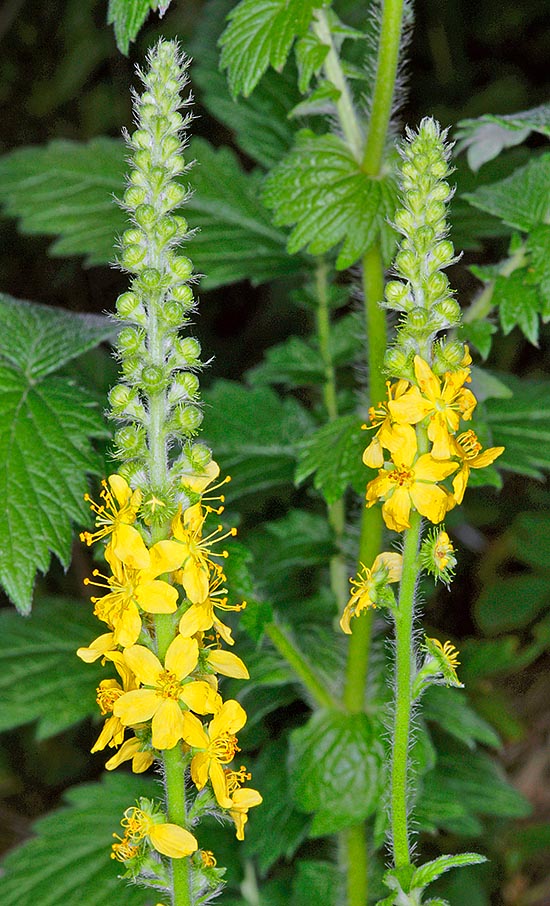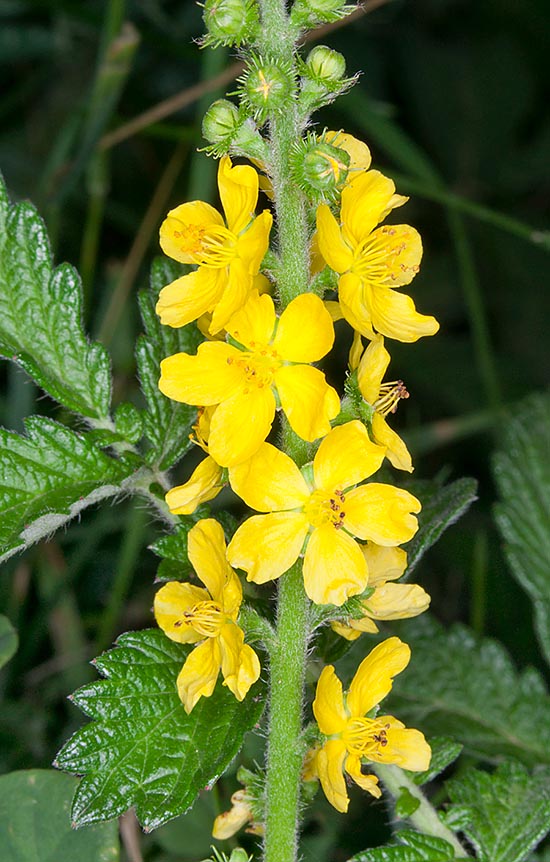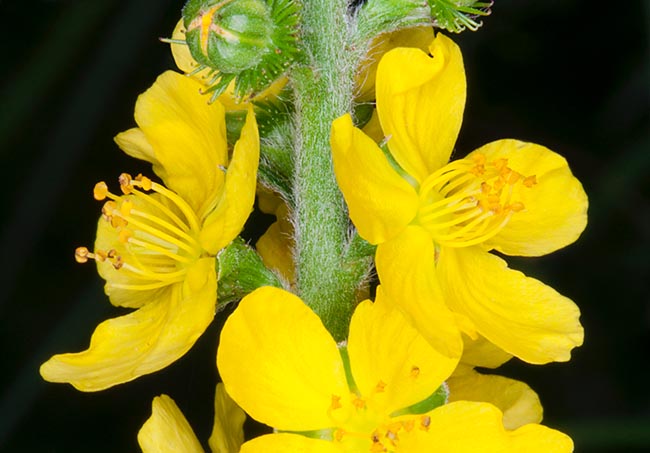Family : Rosaceae

Text © Eugenio Zanotti

English translation by Mario Beltramini

Agrimonia eupatoria grows in boreal hemisphere temperate regions © Giuseppe Mazza
After various authors, the genus Agrimonia includes 12 to 15 species of perennial herbaceous plants; the Common agrimony or church steeples (Agrimonia eupatoria L. 1753) grows in the temperate regions of Eurasia, introduced in North America.
Some authors date back the origin of the name of the genus Agrimonia to the Greek “agros” = field, and “monos” = solitary, that is the wild and solitary places, due to the habitat of the species; for others, instead, from the distortion of the term “argemónia”, from the Greek árghemon, albugo or eye leucoma, as it was thought that the plant did treat the eyes cataract, after others, referred to a species of poppy (probably Papaver argemone).
The name of the species has been honoured by Carl Linnaeus to the famous physician herbalist Mitridate VI Eupatore, King of Ponto (132-63 BC), who is thought of having been the first to discover the therapeutic properties of the plant and to introduce them to the physicians of old Greece who then used it for treating the liver and spleen diseases.
Likely is also the relation with the Greek terms “hépar”, “hépatos”, for the medical employments of the plant used in the past for treating the chronic leaver diseases.
The common agrimony, called also church steeples or sticklewort, is a perennial herb with an elegant bearing, on average 30 to 70 cm (< 130) tall, with cylindrical stem, often reddish, covered by long hairs, short and mixed glandular, which comes out from an oblique and enlarged-nodose rhizome.
It has alternate leaves, furnished at the base of two incised stipules, wrapping the stem, imparipinnate foliar laminae, usually shorter than the internodes, the basal ones very close and thick, so much to resemble a rosette.
The leaves have oblanceolate contour (6-8 x 10-15 cm) and irregularly pinnate lamina, with 4-5 pairs of main segments (up to 2,5 x 5 cm) and short ones (5-15 mm) intercalated and with jagged borders.
The upper page is green and the lower is pale, grey-velvety, with non-odorous sub-sessile glands.
The inflorescence is an elongated (10-30 cm) spiciform raceme; floral peduncles folded at the fructification. Calyx with two basal bracts, campanulate, externally crossed by 10 grooves intercalated by salient ribs. Triangular sepals, 1,5 mm long, five obovate petals of a nice luminous yellow (2 x 3,5 mm); 10-20 stamina, fruit (3 x 7 mm) at the axil of a bract divided in five laciniae.
The blooming can start in April and last up to October but is concentrated in June-July. The fruits contain two, or rarely one, seeds, in the upper half it has a ring of hooked quills favouring the zoophilic dissemination (conveyance of the fruits and/or the seeds by means of the animals). Besides the nominal species (subsp. eupatoria) in Europe are present also the subsp. grandis and subsp. asiatica.

The inflorescence is a 10-30 cm long spiciform raceme © Giuseppe Mazza
The agrimony grows in the grassy locations, in the dry woods, in arid meadows, in pastures, and in the uncultivated areas, close to rubbles, along the border of the roads and of the banks of ditches, from the plain up to the 1000 (<1500) m of altitude. The fruits of agrimony have been found in remarkable quantities in the deposits of the Neolithic stations but their use is unknown. It is a species collected in its natural stations of growth, but is also cultivated and exported in some European countries, especially Bulgaria, Hungary and states of former Yugoslavia.
The main constituents of the leaves and of the flowered tops (harvested during the blooming and dried in the shade in aerated spaces) are the ursolic acid (or urson) with activity similar to the cortisone, found also in the blueberry, in the bearberry, besides in the waxy covering of the grape, the prunes and other fruits, and other triterpenes (1,5% in the leaves), the glucoside eupatorin, catethic tannins (up to the 5%), phytosterols, alpha-amyrin, flavonoids (quercetin, kaempherol), gums, silicic acid (up to the 12%), citric, malic, nicotinic, ascorbic acids, vitamins K and B1. For this plant (Agrimoniae herba) have been confirmed choleretic and cholagogue, anti-inflammatory in the rheumatic and muscular forms, antipruritic, decongestant, antiallergic, hypoglycaemic, antidiar- rheic, antiseptic and cicatrizant properties and is consequently employed in phytotherapy in the gastroenteritis, intestinal inflammations, prostatitis and benign prostatic hypertrophy, gallbladder diseases, useful in the hepatic insufficiencies, anticoagulant, anti-inflammatory of the oral cavity (pharyngitis, tonsillitis, inflamed and bleeding gums, stomatitis), allergic rhinitis and itchy dermatitis, conjunctivitis.
For external use, it is an effective treatment of sores and of varicose ulcers. Some centuries ago, this plant was known among the solders as medicine for the wounds and was used for preparing a famous “water”: the eau d’arcquebusade. For producing (as per King Francis I order in the XVI century) this old ‘water’ were utilized seventy-five species of aromatic and medicinal plants, was quickly known as a remedy for various diseases and infection of the skin; it is still produced in France.
The flowered tops of the agrimony, until mid ‘800, were sought after by dyers for colouring of yellow or white-cream the fabrics and by the opera singers who used it for preparing infusions for gargles before the concerts to maintain a good voice for long time.
Preparations
Infusion for treating colitis, intestinal inflammations, adjuvant in the prostate hypertrophy
To boil a cup of water, remove from flame, add a teaspoon of leaves and flowered tops of dried agrimony and leave in infusion for fifteen minutes. To consume twice a day away from meals.
Decoction to employ for gargles in cases of aphthae

Laves and flowers, once used for dyeing fabrics, have various uses in phytotherapy © Giuseppe Mazza
Put 90 grams of dried flowered tops in one litre of cold water, boil for three minutes and let cool, filter and pour squeezing the residue; store in the fridge in a sealed glass bottle. To gargle every three hours. The same decoction can be used also as an ordinary mouthwash.
Synonyms :
Agrimonia eupatoria var. glabra W.P.C. Barton (1815); Agrimonia eupatoria L. var. hirsuta W.P.C.Barton (1815); Agrimonia eupatoria var. hirsuta Torr. (1824); Agrimonia eupatoria L. var. parviflora Hook. (1832); Agrimonia eupatoria var. mollis Torr. & A.Gray (1840); Agrimonia eupatoria subsp. procera (Wallr.) Arrh. ex Fr. (1842); Agrimonia eupatoria L. var. suaveolens Kuntze (1891); Agrimonia eupatoria subsp. odorata Bonnier & Layens (1894); Agrimonia eupatoria proles odorata sensu Rouy (1900); Agrimonia eupatoria var. grandis Andrz. ex Asch. & Graebn. (1902); Agrimonia eupatoria subsp. officinalis Gams (1923); Agrimonia eupatoria L. f. rosulata Skalický (1973); Agrimonia eupatoria subsp. grandis (Andrz. ex Asch. & Graebn.) Bornm. (1940).
Others: Agrimonia acutifolia, Agrimonia aitchisonii, Agrimonia americana, Agrimonia asiatica, Agrimonia bracteata, Agrimonia conopsea, Agrimonia convergens, Agrimonia coreana, Agrimonia dahurica, Agrimonia davurica, Agrimonia elata, Agrimonia glabrata, Agrimonia glandulosa, Agrimonia godetiana, Agrimonia gorovoi, Agrimonia gotectiana, Agrimonia graeca, Agrimonia grandis, Agrimonia granulosa, Agrimonia japonica, Agrimonia lanata, Agrimonia leroyi, Agrimonia microcarpa, Agrimonia nepalensis, Agrimonia nipponica, Agrimonia x nipponopilosa, Agrimonia obtusifolia, Agrimonia odorata, Agrimonia parvi flora, Agrimonia pilosa, Agrimonia patycarpa, Agrimonia polyphylla, Agrimonia procera, Agrimonia pumila, Agrimonia repens, Agrimonia robusta, Agrimonia rostellata, Agrimonia serrifolia, Agrimonia sororia, Agrimonia striata, Agrimonia suaveolens, Agrimonia suffrutescens, Agrimonia tokiatensis, Agrimonia velutina, Agrimonia viscidula, Agrimonia x wirtgenii, Agrimonia zeylandica.
→ To appreciate the biodiversity within ROSACEAE family please click here.
